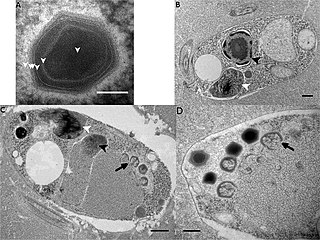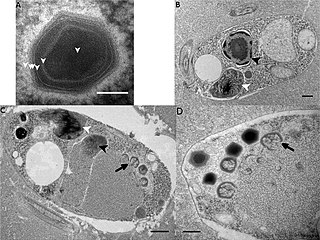
Mimivirus is a genus of giant viruses, in the family Mimiviridae. Amoeba serve as their natural hosts. This genus contains a single identified species named Acanthamoeba polyphaga mimivirus (APMV). It also refers to a group of phylogenetically related large viruses.

Metagenomics is the study of genetic material recovered directly from environmental or clinical samples by a method called sequencing. The broad field may also be referred to as environmental genomics, ecogenomics, community genomics or microbiomics.

Bodo is a genus of microscopic kinetoplastids, flagellate excavates first described in 1831 by Christian Gottfried Ehrenberg. The genus is small, as it has recently been redefined to include only four species. Bodo includes free-living, phagotrophic organisms that can be found in many marine and freshwater environments as well as some terrestrial environments. Being phagotrophic, Bodo feeds on bacteria and other microorganisms that it finds while swimming through its water-based habitats. The swimming-like movement is facilitated by the two unequal flagella that Bodo possesses which arise from an anteriorly located flagellar pocket. Bodo is roughly bean-shaped and is often missed in samples from water or terrestrial environments due to its small size.

Bodo saltans is a free-living nonparasitic species of kinetoplastid flagellated phagotrophic protozoa that feed on bacteria. Bodo saltans cells have been reported in freshwater and marine environments.
Phycodnaviridae is a family of large (100–560 kb) double-stranded DNA viruses that infect marine or freshwater eukaryotic algae. Viruses within this family have a similar morphology, with an icosahedral capsid. As of 2014, there were 33 species in this family, divided among 6 genera. This family belongs to a super-group of large viruses known as nucleocytoplasmic large DNA viruses. Evidence was published in 2014 suggesting that specific strains of Phycodnaviridae might infect humans rather than just algal species, as was previously believed. Most genera under this family enter the host cell by cell receptor endocytosis and replicate in the nucleus. Phycodnaviridae play important ecological roles by regulating the growth and productivity of their algal hosts. Algal species such Heterosigma akashiwo and the genus Chrysochromulina can form dense blooms which can be damaging to fisheries, resulting in losses in the aquaculture industry. Heterosigma akashiwo virus (HaV) has been suggested for use as a microbial agent to prevent the recurrence of toxic red tides produced by this algal species. Phycodnaviridae cause death and lysis of freshwater and marine algal species, liberating organic carbon, nitrogen and phosphorus into the water, providing nutrients for the microbial loop.

Virophages are small, double-stranded DNA viral phages that require the co-infection of another virus. The co-infecting viruses are typically giant viruses. Virophages rely on the viral replication factory of the co-infecting giant virus for their own replication. One of the characteristics of virophages is that they have a parasitic relationship with the co-infecting virus. Their dependence upon the giant virus for replication often results in the deactivation of the giant viruses. The virophage may improve the recovery and survival of the host organism.

Mimivirus-dependent virus Sputnik is a subviral agent that reproduces in amoeba cells that are already infected by a certain helper virus; Sputnik uses the helper virus's machinery for reproduction and inhibits replication of the helper virus. It is known as a virophage, in analogy to the term bacteriophage.

Mimiviridae is a family of viruses. Amoeba and other protists serve as natural hosts. The family is divided in up to 4 subfamilies. Viruses in this family belong to the nucleocytoplasmic large DNA virus clade (NCLDV), also referred to as giant viruses.
Mamavirus is a large and complex virus in the Group I family Mimiviridae. The virus is exceptionally large, and larger than many bacteria. Mamavirus and other mimiviridae belong to nucleocytoplasmic large DNA virus (NCLDVs) family. Mamavirus can be compared to the similar complex virus mimivirus; mamavirus was so named because it is similar to but larger than mimivirus.

Cafeteria roenbergensis virus (CroV) is a giant virus that infects the marine bicosoecid flagellate Cafeteria roenbergensis, a member of the microzooplankton community.
Organic Lake is a lake in the Vestfold Hills in eastern Antarctica. It was formed 6,000 years ago when sea levels were higher; it is isolated, rather shallow 7.5 metres (25 ft), meromictic, a few hundred meters in diameter and has extremely salty water. It has the highest recorded concentration of dimethyl sulfide in any natural body of water.
A giant virus, sometimes referred to as a girus, is a very large virus, some of which are larger than typical bacteria. All known giant viruses belong to the phylum Nucleocytoviricota.

Mimivirus-dependent virus Zamilon, or Zamilon, is a virophage, a group of small DNA viruses that infect protists and require a helper virus to replicate; they are a type of satellite virus. Discovered in 2013 in Tunisia, infecting Acanthamoeba polyphaga amoebae, Zamilon most closely resembles Sputnik, the first virophage to be discovered. The name is Arabic for "the neighbour". Its spherical particle is 50–60 nm in diameter, and contains a circular double-stranded DNA genome of around 17 kb, which is predicted to encode 20 polypeptides. A related strain, Zamilon 2, has been identified in North America.

Klosneuvirus is a new type of giant virus found by the analysis of low-complexity metagenomes from a wastewater treatment plant in Klosterneuburg, Austria. It has a 1.57-Mb genome coding unusually high number of genes typically found in cellular organisms, including aminoacyl transfer RNA synthetases with specificities for 19 different amino acids, over 10 translation factors and several tRNA-modifying enzymes. Klosneuvirus, Indivirus, Catovirus and Hokovirus, are part of a group of giant viruses denoted as Klosneuviruses or Klosneuvirinae, a proposed subfamily of the Mimiviridae.

Tupanvirus is a genus of viruses first described in 2018. The genus is composed of two species of virus that are in the giant virus group. Researchers discovered the first isolate in 2012 from deep water sediment samples taken at 3000m depth off the coast of Brazil. The second isolate was collected from a soda lake in Southern Nhecolândia, Brazil in 2014. They are named after Tupã (Tupan), a Guaraní thunder god, and the places they were found. These are the first viruses reported to possess genes for amino-acyl tRNA synthetases for all 20 standard amino acids.

Chrysochromulina ericina virus 01B, or simply Chrysochromulina ericina virus (CeV) is a giant virus in the family Mimiviridae infecting Haptolina ericina, a marine microalgae member of the Haptophyta. CeV is a dsDNA virus.
Hokovirus (HokV) is a genus of giant double-stranded DNA-containing viruses (NCLDV). This genus was detected during the analysis of metagenome samples of bottom sediments of reservoirs at the wastewater treatment plant in Klosterneuburg, Austria. New Klosneuvirus (KNV), Catovirus and Indivirus genera were also described together with Hokovirus, building up a putative virus subfamily Klosneuvirinae (Klosneuviruses) with KNV as type genus. Hokovirus has a large genome of 1.33 million base pairs. This is the third largest genome among known Klosneuviruses after KNV and Catovirus. GC content is 21.4 % Classification of metagenome, made by analyzing 18S rRNA indicate that their hosts are relate to the simple Cercozoa.
Indivirus (IndV) is a genus of giant double-stranded DNA-containing viruses (NCLDV). This genus was detected during the analysis of metagenome samples of bottom sediments of reservoirs at the wastewater treatment plant in Klosterneuburg, Austria. New Klosneuvirus (KNV), Hokovirus and Catovirus genera were also described together with Indivirus, building up a putative virus subfamily Klosneuvirinae (Klosneuviruses) with KNV as type genus. Indivirus has a genome of 0.86 million base pairs. This is the smallest genome among Klosneuviruses as mentioned above. GC content is 26.6 % Classification of metagenome, made by analyzing 18S rRNA indicate that their hosts are relate to the simple Cercozoa.
Nucleocytoviricota is a phylum of viruses. Members of the phylum are also known as the nucleocytoplasmic large DNA viruses (NCLDV), which serves as the basis of the name of the phylum with the suffix -viricota for virus phylum. These viruses are referred to as nucleocytoplasmic because they are often able to replicate in both the host's cell nucleus and cytoplasm.

The Bodo saltans virus is a giant virus of the Mimiviridae family that infects the protozoa Bodo saltans. It has a genome of 1.39 megabases, one of the largest known viral genomes.









